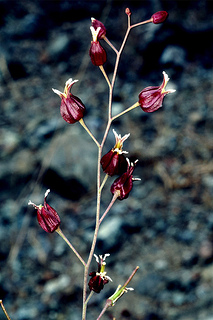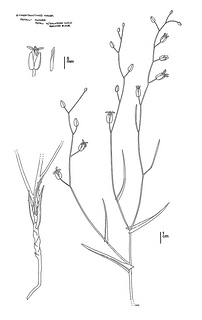(Streptanthus glandulosus ssp. niger)
 Streptanthus glandulosus ssp. niger. Photo © Rick York and CNPS.
Streptanthus glandulosus ssp. niger. Photo © Rick York and CNPS.
 Streptanthus glandulosus ssp. niger. CDFW illustration by Mary Ann Showers. (Click to enlarge)
Streptanthus glandulosus ssp. niger. CDFW illustration by Mary Ann Showers. (Click to enlarge)
Tiburon jewelflower is a California endangered plant species, which means that killing or possessing this plant is prohibited by the California Endangered Species Act (CESA). This species is also listed as endangered under the federal Endangered Species Act. Tiburon jewelflower is an annual herb in the mustard family (Brassicaceae) that grows from one to two feet tall, and produces dark purple flowers which typically bloom in May and June. This species grows on shallow, rocky serpentine soils on southwest facing slopes of the Tiburon Peninsula in Marin County. Associated species include foothill needle grass (Stipa lepida), purple needle grass (S. pulchra), hayfield tarweed (Hemizonia congesta ssp. congesta), and Tiburon buckwheat (Eriogonum luteolum var.caninum), and also two state and federally listed species, Marin western flax (Hesperolinon congestum) and Tiburon paintbrush (Castilleja affinis ssp.neglecta). At the time of this webpage posting, the California Natural Diversity Database reports two extant occurrences of Tiburon jewelflower, which occur on the southern end of the peninsula within two miles of each other. One population occurs at the tip of the peninsula at Old St. Hilary’s Church Preserve, which is partially protected by Marin County Open Space, and the other is along the Middle Ridge of the peninsula, which is protected by the Town of Tiburon Open Space. Population numbers fluctuate yearly, from 50 to 2,000 individuals per location.
The primary threats to Tiburon jewelflower are urban development and foot traffic. Although the populations are at least partially protected, a portion of the Old St. Hilary’s Church Preserve site is proposed for development. Even in areas where the habitat is protected, surrounding development results in increased foot traffic, dog walking and off-leash dogs, erosion, increased runoff, and encroachment of non-native invasive plants. The restricted range and small population sizes of Tiburon jewelflower place it at risk of extinction from catastrophic or stochastic events and loss of genetic variability. Climate change may also threaten the survival of the species.
The continued existence of Tiburon jewelflower is dependent upon preservation and protection of its entire occupied habitat in perpetuity. Research should be conducted on this species, specifically on demography, reproduction and genetics, and an ongoing standardized annual monitoring program should be implemented to monitor population sizes. A seed bank should be created and maintained at a qualified seed banking facility, and efforts should be undertaken to understand the potential effects of global climate change on the habitat and microclimate of the Tiburon Peninsula.
CDFW may issue permits for Tiburon jewelflower pursuant to CESA, and you can learn more about the California laws protecting Tiburon jewelflower and other California native plants. Populations of Tiburon jewelflower occur in CDFW’s Bay Delta Region. More information is also available from the U.S. Fish and Wildlife Service Species Profile for Tiburon Jewelflower.
Updated 01/15/2014